Well, just because I buggered up the wing is no excuse to not get something done. I finished up the ribs anyway and set them aside for later installation.
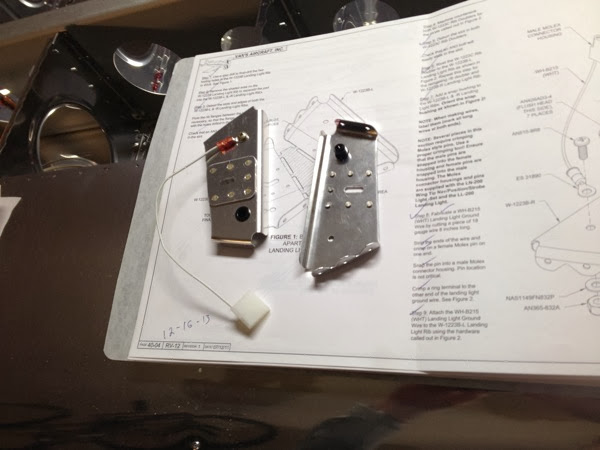
Well, just because I buggered up the wing is no excuse to not get something done. I finished up the ribs anyway and set them aside for later installation.

Well, I made a pretty good “oops” the other day (12-16-13). (I typically post on this blog when things are slow at work, and I actually had several days off, so I’m late posting here.)
Take a good look at the photo, see if you can see what’s wrong. I’ll give you a hint: the landing light ribs aren’t making contact with the lower surface of the wing—why not?
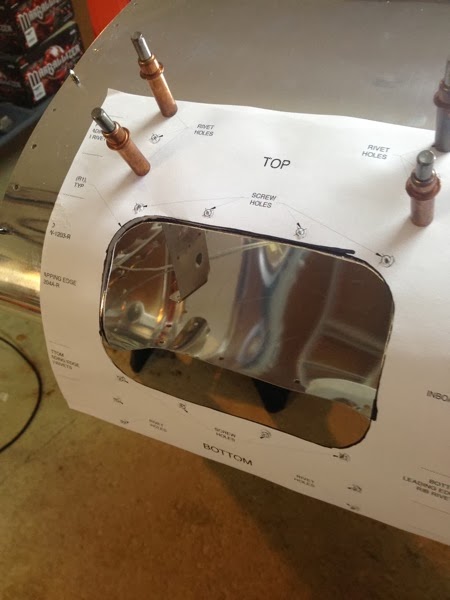
Looking inside the hole cut in the leading edge of the wing, you can see the outer landing light rib clecoed to the upper surface of the wing, but it’s a good 1” away from the lower surface. The paper template was aligned with the rivet holes on the outside edge and the next rib inboard. (I originally used a strip of tape from the marks on the paper to the holes to verify good alignment.) So what’s up?
Look all the way at the very left edge of the picture. (BTW, I took this picture in preparation for posting a plea for a diagnosis on VAF. Right after I took the picture, I saw the problem.) I lined up the template with rivet holes #2 - 4, instead of #1 - 3. I just didn’t see hole #1, probably because it’s got an inverted cleco sticking out of it. Damn.
As soon as I figured it out, I sat down and ordered a replacement W-1203-R, list price of $85 (with a footnote saying shipping will be added). I was very pleasantly surprised to get a notification from the bank that my card was charged only $143 on the 18th, and a FedEx note saying that I should get delivery on the 24th. Not nearly as bad as it could have been. The last bit of penance for this oops is drilling out about 300 rivets to take off the ruined skin.
The new skin arrived today. When I got home from work this morning I could see a nice tall box left out on the front porch. Only problem was the box was kinda square, not exactly the shape I was expecting. To be more descriptive, it was about 5’ tall but roughly 18” x 24” (no, I’m not OCD enough to have measured it). I didn’t think that the wing skin could be in there and that I received the wrong part. Much to my surprise, the skin was rolled up like a newspaper and standing on edge.

Note the highlight on the surface closest to the camera: it’s actually the leading edge fold that has been opened up instead of folded closed. I’m amazed at how springy the aluminum is and that it doesn’t encounter plastic deformation with these manipulations. Below is a picture with the duct tape cut and the skin placed on the injured wing, over the skin it will replace.
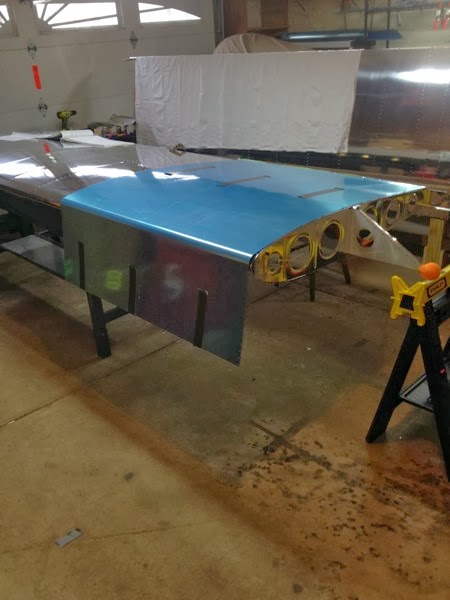 Replacement Skin, pre-positioned
Replacement Skin, pre-positionedNow all I have to do is find the time to drill out the ~300 rivets to remove the 1st skin. BTW, I did drill out the 20 rivets on the upper surface. I broke my #52 bit in the process... :-(
OK, got the skin off. I learned quite a few drilling-out-rivet techniques. At first I used a #52 from the local hardware store to drill out the steel ‘pits’ as I have taken to calling them. That lasted about 5 rivets before the cheap bit broke. Then I went to using a #40 bit and following with a #30. Towards the 2nd half of the project, I just went with the #30 and got very good at quickly popping off just the heads and then lightly drilling until the stressed skin suddenly released its tension and could be moved. After I remembered to remove all of the cleverly hidden (inside) clecos, the skin came off nicely. I then returned to the naked ribs and drilled out the bottom halves of the rivets.
Not surprisingly, there are some ugly holes due to drill bit wandering as it tried to go through the steel pits and ended up going to one side or another.
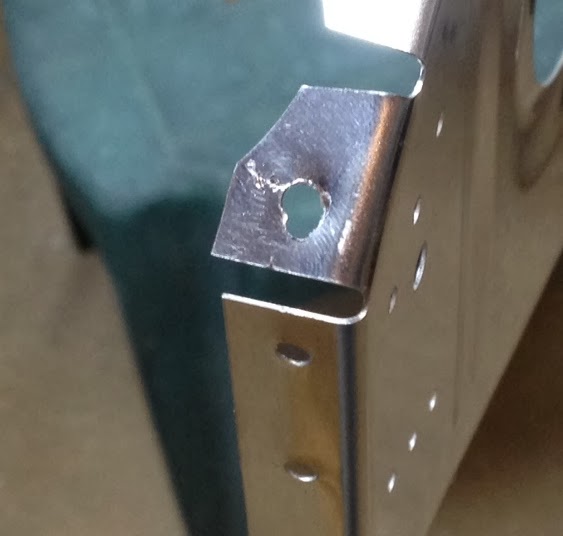
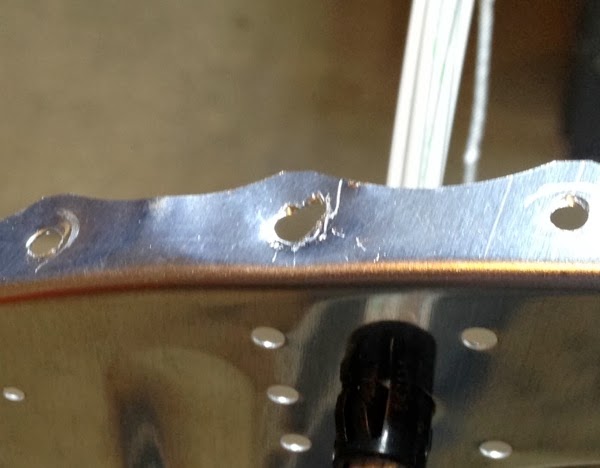
I posted the following on Van’s Air Force. For now, I’m closing down the shop and enjoying another 24 of my 60 hour vacation.
Hi guys,
I'm looking for confirmation (or not) that I'm doing a repair correctly. I screwed up the landing light cutout on the R outboard leading edge wing skin, thus I spent all day today removing said skin in order to replace it. I have drilled out all of the rivets and removed the skin itself. Not surprisingly, some of the drilled out holes are out of tolerance for being re-riveted.
Question #1: I'm using 50 % out of round as my upper limit of acceptable for re-riveting. Is this reasonable? I can't remember where I learned it, and haven't had much luck finding the original reference (if it exists.)
Question #2: Assuming the above criteria, I have about 20 holes that will need something other than an LP4-3. I have some 5/32" rivets from the local hardware store. Is it acceptable to match drill the new skin with a 5/32" bit and use those rivets?
Thanks for any feedback,
-dbh
I got a lot of feedback about not using store bought rivets because they have no specifications, so you can’t tell if they are adequate. On the other hand, I certainly couldn’t find any specs for Van’s LP4-3’s. One VAF poster sent this link (http://blindrivets.gesipausa.com/vie...-steel-mandrel) to a rivet company with the claim that their product was, in fact, Van’s LP4-3. It certainly looks like an LP4-3, so I’m going with it. I requested a comparable 5/32” rivet via their web page, but I think they’re closed for the holiday week. I’ll mark the following holes as “do not rivet” when I attach the skin later this week:
Larger Rivets
Ribs are counted from outboard edgeHoles are counted from main spar#2 Nose Rib 20#2 Main Rib 11,#3 Nose Rib 1, 22#3 Main Rib 1, 9, 10, 13, 23#4 Nose Rib 1, 15, 16, 18
Not too bad; a total of 13 rivets out of > 300 drilled out. BTW, no one commented on my criterion of “> 50 % out of round.” The more I though about it, the less sure I could be objective about what constituted 50 % out of round. I used a more objective criterion: I placed an LP4-3 into each hole. If I could see any hole beyond the edge of the rivet, then I called it “oversized” and put it on the above list.
Anyway, Nick & I put the skin on and I clecoed it in place. I’ll rivet it later this week.
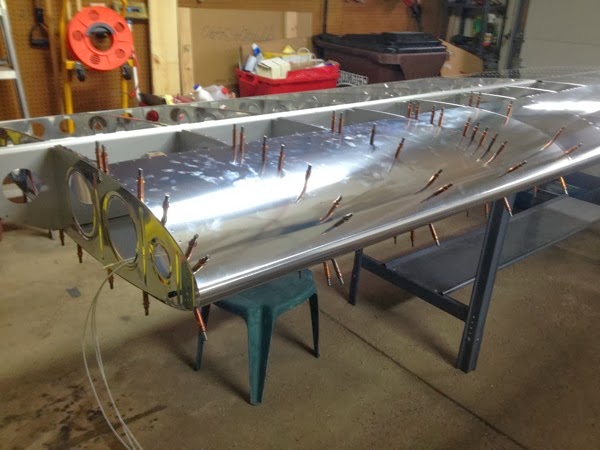
OK. The new skin is replaced, with the exception of the 13 oversized rivets to be placed upon their arrival. The rest of the rivets were placed w/o any difficulty. Total time: 16 days. Total cost ~$200. I guess that counts as a learning experience!
I’ve had several days of working on attaching the lower skins to the Right wing. I’ve actually accomplished a little bit more than what is called out on page 17-02, as I have also riveted the leading edges. This wing was ribbed and skinned while on saw horses, so that the chord was vertical. As mentioned elsewhere, I did this to avoid possibly bending the ribs, but also to learn different ways of doing things. I was surprised at how much sag there was in the middle of the span, and I needed to put some support under the rear spar to allow the skins to line up with the holes. All in all, very boring repetitive work, but intensely satisfying.
Clecoed in place
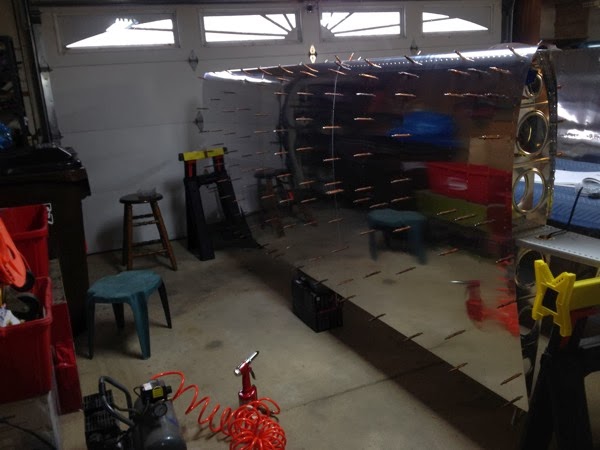
Riveted in place
(lower surface only, in this picture. You can see some clecos peaking over the leading edge.)
Next step will be another detour to chapter 40, to install the landing light. I want to leave the upper skins off while I install that light, as I have a sneaky feeling that being able to reach from behind will be very helpful. Once the light is in place, the upper skins go on and I build out the wing tips and the inboard edges as per plans.
Bob pointed out that I won’t be able to finish the wingtip lights since they require fiberglass / epoxy work, and that needs ambient temps above 70 °F. Since it’s a pleasant 15 °F right now, I expect that that will be a spring time project.
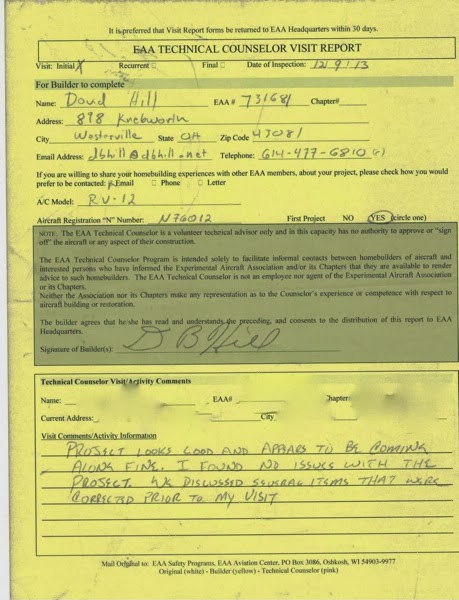
I ran all of the wires for the wings before putting on the skins. While it was easier to see the grommets and run the wires, I fretted about bending the ribs excessively. Engineering is always about tradeoffs and this was a perfect example. Although there were no actual problems, I can see that having the skins on would have provided much more stability to the ribs during the pulling process. Live & learn.
Anyway, here are the pictures of the R & L wing electrical connectors. Note the R wing has the female half and the L is male for the floating connectors. These are interesting connectors: the female is mounted with deliberately loose bushings and there are 3 cm long pin/sockets to allow a little bit of wiggle room (imperfect alignment) as the parts are mated.
I purchased another set and will make a test jig with 12 Vdc and some switches so I can power up the lights after they are installed. I’d much rather debug anything ‘in situ’ rather than finding out that there’s problem when I’m integrating the wings and the fuselage.
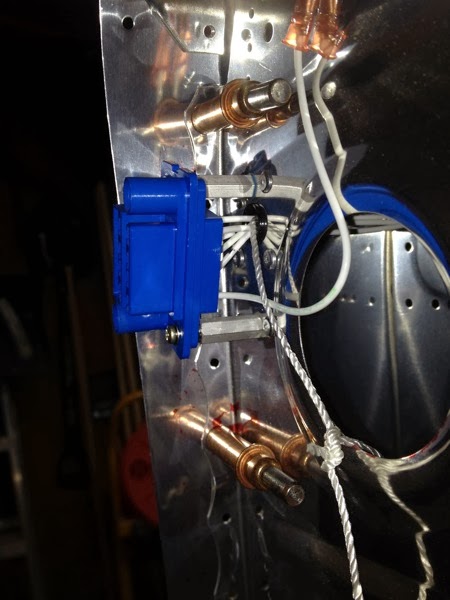
Left wing with male connector. Note the string tied through the lightening holes. Not sure why they requested that I put another string in after the wires are pulled, but that’s what the plans call for, so it’s there. 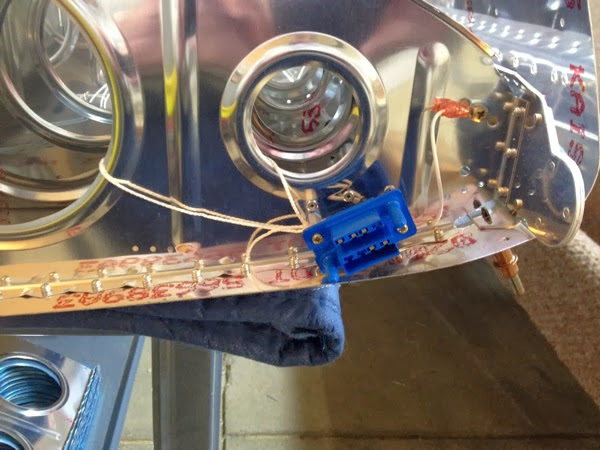
while on a roll, I continued after getting the main ribs on the R wing and attached the nose ribs without any complications. It felt good to work on the plane today, even if it cost me two hours of sleep...
Clecoed in place, confirming all are aligned well. This photo is aligned along the notches on the upper surface. Note the electrical connector, pre-installed.
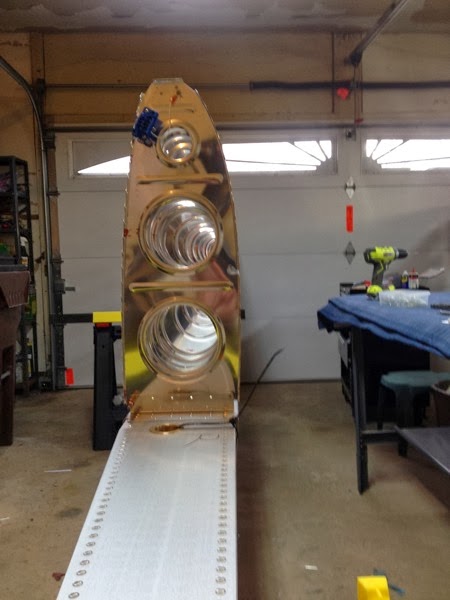
R wing with all ribs and spars. Next: skins!
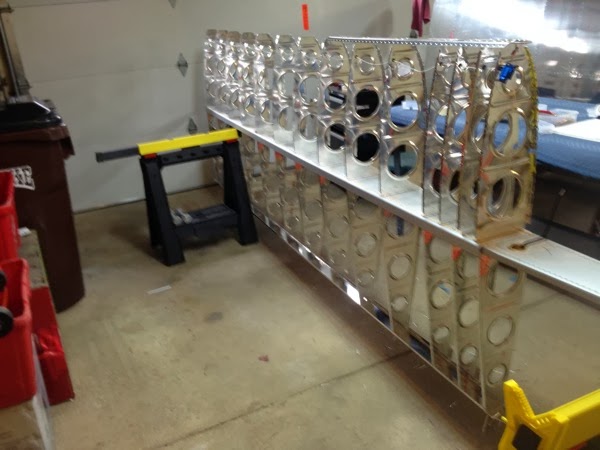
Many days of little bits of progress, but I finally got the main ribs on the R wing spar.
The first thing I did for the ribs was pull all of the blue plastic off. Took 45 min to strip 28 ribs. I remember reading that heat helps the adhesive to peel off, but my garage was pretty cold. I use this propane ‘torpedo’ heater to warm things up. I discovered that holding the blue rib in front of the blast from the torpedo would warm it up in about 5 seconds and greatly facilitated removing the snake skins. You can see the pile I created in the process.
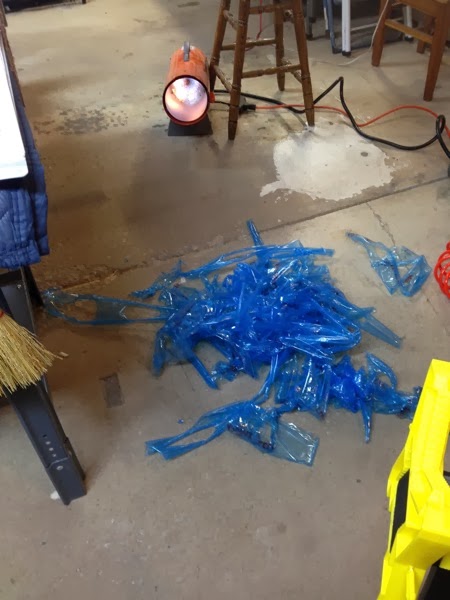
Here’s a pretty typical shot, the main ribs are clecoed in place and I am verifying that things align well before proceeding with rivets.
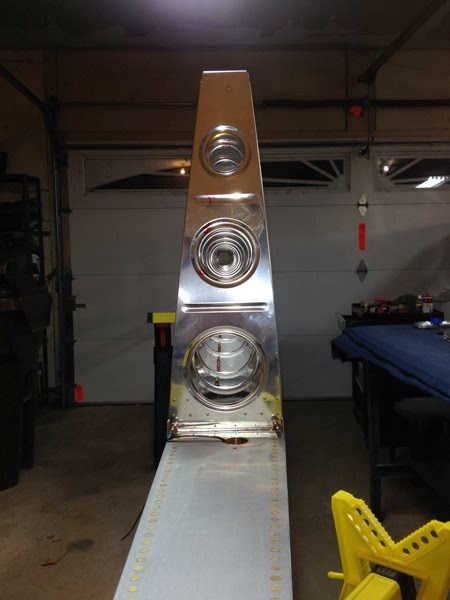
Another view of the clecoed ribs. 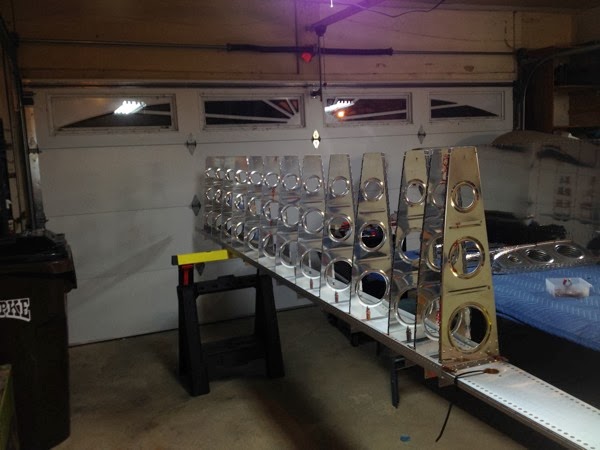
OK, take a close look at the rivet on the vertical surface in this before & after pair. Do you see the slight gap in the 1st photo? The reason I took those pictures is because I noted that I hadn’t gotten a good, firm seat of the rivet before pulling the trigger, so it was “loose.” I simply noted it, put down the rivet gun and reached for my #52 drill to drill it out before I realized that this was just a matter of fact and not one that got me all worked up about having to remove a rivet. OK, enough of demonstrating that I’m growing up. :)
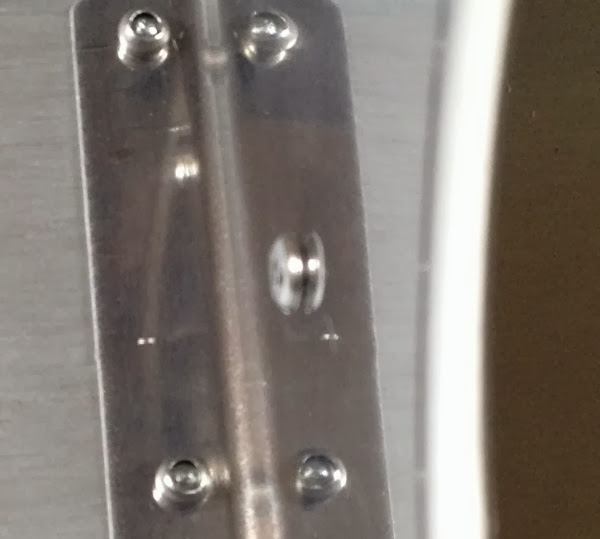
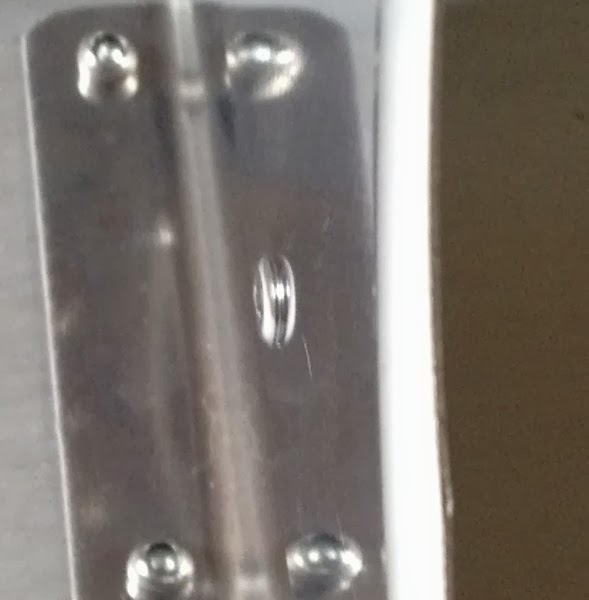
Main ribs in place, with rear spar attached.
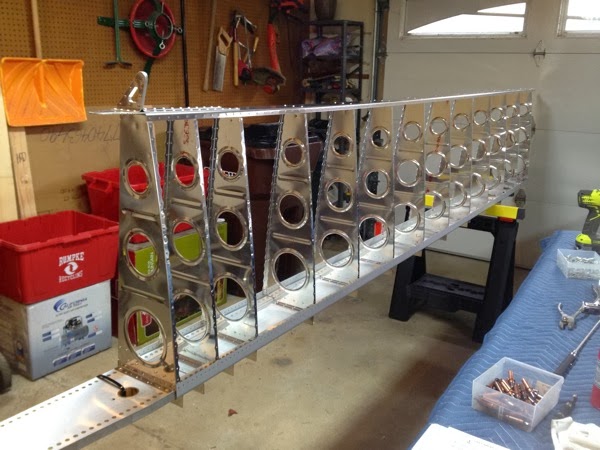
Another of my ‘favorite view’ shots.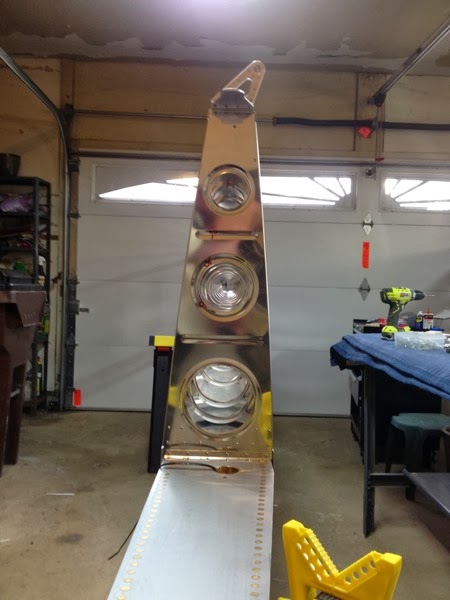
I’ve got an interesting job. I work the night shift at a small ER in rural Ohio. Sometimes we have patients waiting for hours to be seen, other times we are bored silly. Tonight would be the latter, so I have time to post a blog, even if there’s no progress (regarding building) to report.
One of my other aviation hobbies (besides building ‘012) is collecting ratings. I currently hold a CFI-Airplane and am studying to add on CFI-Instrument. I don’t instruct for a living, and have only accumulated about 17 hours of Dual Given since I earned that ticket 2 years ago. Nonetheless, it’s that CFI-A that finally helped me to decide that N76012 will be an E-LSA with any customizations done after obtaining her airworthiness certificate.
What’s that, you say? How do those facts fit together? Simple. You may not use an EAB aircraft for commercial purposes. I might, just might, get a fancy to do instruction in 012. Can’t do that if she’s EAB, but it is legal if she’s an E-LSA. All of the other advantages of potential sell-ability, no need for the dreaded ‘Experimental’ warning / label, and potentially lower insurance all apply.
I will be meeting with an EAA Tech Inspector next week. I’ll check with him how much provisioning for future modifications may be made without endangering the E-LSA designation. I’ll do whatever is easy to do during assembly, as long as it doesn’t put that E-LSA at risk. I will also have to work with the FSDO and the bank to change the paperwork that has already been started by First Pryority Bank, since they have established their lien on the plane by legally creating it as an EAB. Those bridges can be crossed.
Oh, by the way, work is seriously interfering with my life. I’m working 10 out of 11 days right now, and have had no appreciable time to make any progress in the garage. Just so you know, I’ve started work on the R wing and have half of the main ribs attached to the main spar. I don’t expect that I’ll have any shop time until the 11th... :(
talk to you then,
-dbh
This was, as expected, tricky and tedious, but not nearly as tricky as I think it could have been! It does’t look like much, does it...?
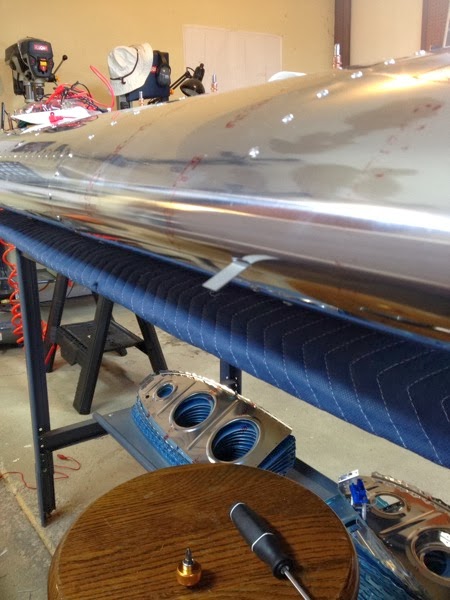
Well, that little tongue sticking out is the stall warning switch. When the plane is flying at a very high angle of attack, the relative wind will force that switch up instead of down. That closes a microswitch hidden beneath the leading edge, thus notifying the pilot of an impending stall. Can you see how much that switch can move? Not much! In other words, I had to get the alignment of the switch assembly to be juuuuust right.
I have rearranged several of the construction steps for just this event. In order to align the switch, I reason that the lower mid skin needs to be in final position—cleco’ed just isn’t good enough (more about that below) for this precision of alignment. Accordingly, I only rough positioned the stall switch assembly last week and waited until I had riveted the lower skins on their lower side and the leading edge. In other words, the skin was in final position.
I was able to reach in the access hole and move the assembly with little difficulty. Much to my surprise, it took less than a minute to get the assembly rotated such that the stall warning vane was (1) 90° to the local curvature, and (2) audibly activated the microswitch. I jury rigged an old analog volt-ohm-meter to the contact in the connector (this would have been nice to have thought about prior to getting all fancy and installing the connector) and verified that I could trigger the VOM with the stall warning vane. The next hour did not go so well.
There was just no way to see the screws in order to tighten the assembly in place. I tried a mirror; my hand blocked my own view. I tried the solid state borescope; way too many reflections, and an oddly long focal length. I tried mating Lada’s and my iPhones with a FaceTime (video call) connection and using one iPhone inside the wing; guess what? Aluminum does a great job of shielding the wifi connection. Resorting to braille and luck, I was able to get the screwdriver engaged in the appropriate screw. The first n times, rotating the screw also rotated the assembly, thus mis-rigging the vane. I finally got the thing tightened and—miracle of miracles—it was still in good position.
Why am I so happy that it only took an hour to tighten two screws? Because the instructions intimated that it was “OK” to bend the arm of the microswitch itself if there wasn’t good switch action when the vane was 90° to the skin. I really don’t know how I would have tried to accomplish that!
As mentioned above, “cleco close” isn’t good enough for some situations. I riveted the leading edges of the skins prior to doing the above stall switch adjustment. I recalled reading that an awl was good for recalcitrant holes that wouldn’t accept a rivet. I had disregarded that, as I had perfect alignment with clecos. Well, I purchased an awl and discovered that it works like a jiffy! A touch of elbow grease provides (1) exact alignment of holes and/or (2) enlargement of the holes such that a LP4-3 is a tight fit, but not a fight to fit. I had to #30 drill exactly 1 hole because an underlying structure did not permit the awl to go the required depth. It’s now sitting in the honored space reserved for ‘daily use’ tools—my practice toolbox.
No big surprises here, the wires have already been pulled and it was pretty straightforward to assemble the electrical connectors. I had a bit of trouble with crimping the pins on the insulation, but the crimps are strong and serviceable, if not pretty and elegant. Oddly, the smaller crimps on the conductors are very nice and look good (with suitable magnification.)
Van’s used an interesting approach for the connectors. One wing gets the male, the other gets female. Logically, I am expecting that there will be a corresponding female and male connector on the fuselage. To pass the time and entertain myself, I spent a few bucks to get an additional set (expecting it next week.) I’ll dummy up the fuselage portion of the wiring and connect a suitable 12v supply and beeper circuit. When the wings are complete, and the lighting kit installed, I will be able to test the lights (position, strobes, landing) and stall warning with the wings in their cradle.
Right wing electrical connector, with ground wire attached. The connector is only loosely screwed to the standoffs, as I will need to install all of the remaining wires for the strobe, position and landing lights.
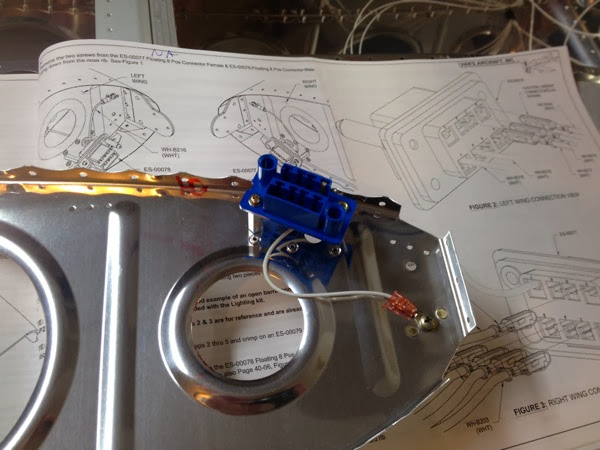
Left wing electrical connector, in situ. The ground is visible, but the strobe & position lighting wiring isn’t seen behind the connector itself. There is a string tied through the lightening holes, as called out by the instructions. (I don’t know why we would leave another string there, unless its just an accepted practice for (inevitable) future mods.) You can see the leading edge of the wing is not attached and nearly vertical at the extreme right edge of the picture.

I’m at a point where I need to decide if I’m going to go EAB or E-LSA. For those who may not be familiar with the acronyms, those represent Experimental Amateur Built and Experimental-Light Sport Aircraft, respectively. Long story, short: EAB is the traditional Experimental category and I can follow the plans as closely or loosely as I see fit. (In other words, I can make modifications.) I would be the Builder and I could do my own annual inspections, or an A&P could do so. I can never rent the aircraft or otherwise receive any compensation for flight time (that includes cost sharing), although I could be paid as an individual since I hold a commercial license.
If I stick to the plans (to the letter) then the plane will be an E-LSA and is essentially a “factory” plane of Van’s which I happened to assemble. I’m still not completely sure of the rules re: who can do annual maintenance, etc., but I know that you aren’t restricted to just hiring an A&P.
The EAB must be prominently labeled “Experimental”, not so for the E-LSA. Might scare potential passengers.
It’s been discussed on VAF that it will be easier to sell as an ELSA vs. EAB, but there’s absolutely no data to support the claim. (to be fair, there’s no data on resell values of either certification of RV-12’s to date, so there’s no data to the contrary, either.)
Those are the facts, but they don’t address the emotion. I’m currently leaning toward EAB as a matter of personal pride, and a desire to implement a couple of mods. The mods aren’t big, but big enough to make a legal distinction. I’d like to put in angle-of-attack and a 2nd landing light. I’m not sure about the split bulkhead, but it sounds like a good idea so far. There’s also an issue with the dorsal skin being too flexible in the vicinity of the AHARS computer and it may need a stiffener of some sort. These are the things that make the EAA a fun place to play, and being registered EAB would be part of that tradition.
More to follow, but I think I’m going to go EAB unless I learn something else in the next week or so.
Not too much to comment on, the lower skins went on without any issues. :0)
This is slightly blurry, but you can see the inboard skin hung on the ribs. The spar is suspended on sawhorses and the skin is hanging on the nose ribs. On the R side of the image you can see the string and stall warning switch wire.
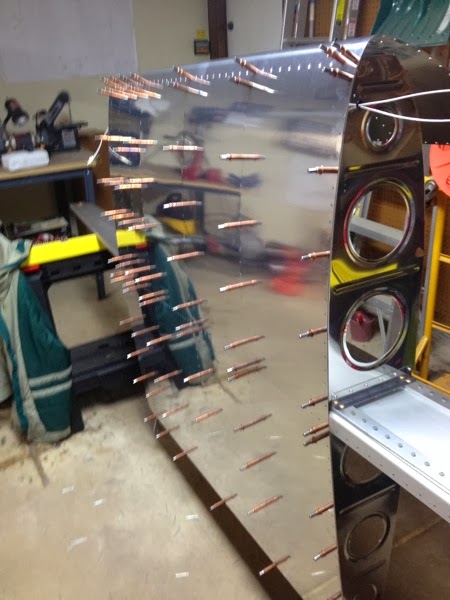
Here’s the finished product (finished with respect to the page, anyway) resting on its upper surface.
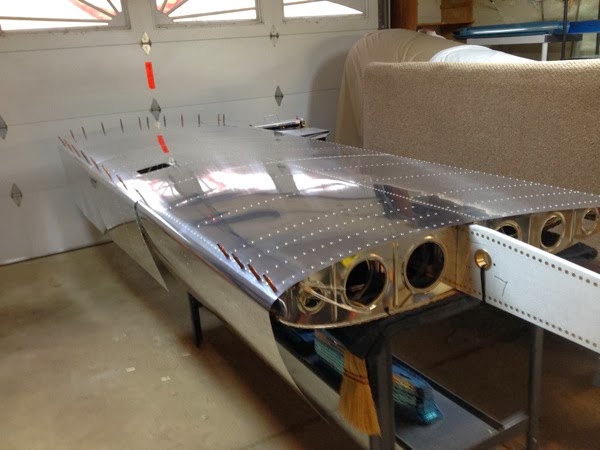
(This assumes that I get any days to myself to work on this. My work schedule is looking pretty ugly for the next few months...)
Nice view of the main ribs clecoed in place. I’ve been pretty worried about my ability to make sure that I get all of the proper “L” and “R” pieces. Sure enough, there’s another error in this picture. I’ll let you look at it a bit before you see the answer below.
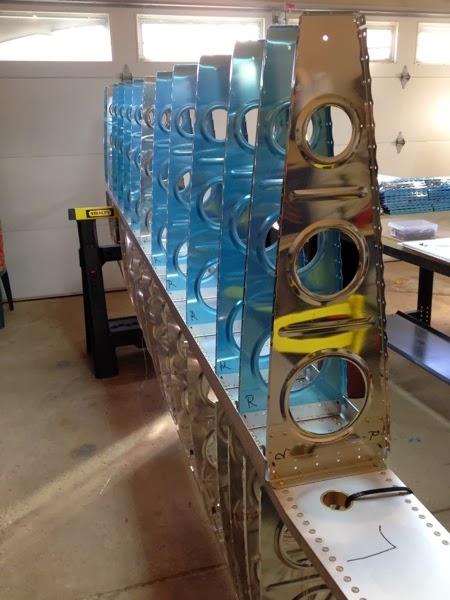
Sure is pretty, isn’t it? I actually like the sky-blue (голубой) color of the protective plastic. I might look for something in that shade for the final paint job. If I’m really feeling whimsical, I’d even think about some decals that look like the manufacturing stamps on the plastic and put those on the plane. Any Van’s builder would get the joke, but not anyone else...
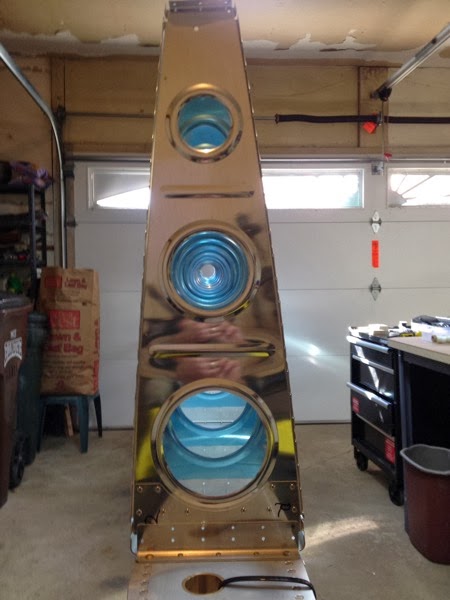
Just another shot, looking at the completed skeleton. 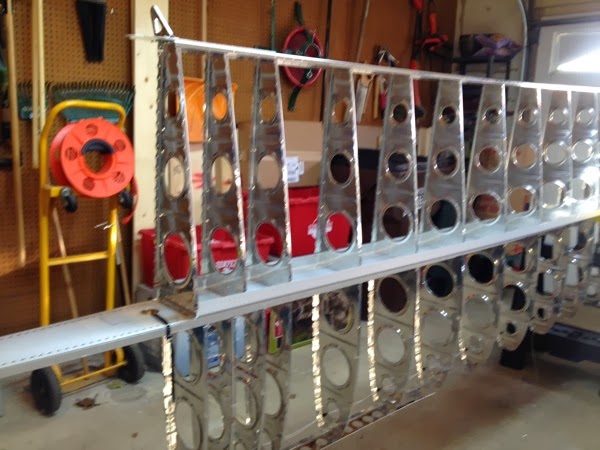
Here’s the clue I alluded to earlier. See those nice LP4-4’s? I have to drill them out to remove the R main rib with the doubler and install the correct (L) doubled rib as called out in step 6. How did I miss that? By not only installing the wrong rib, but installing it on the wrong side of the flange so that the double mirroring made it a very, very subtle thing. As you can see, I had the rear spar fully attached and only discovered the error after clecoing the main skin and noting that the very final holes (this rib) didn’t line up... : (
What’s the good news? I hadn’t riveted the skin! :0)
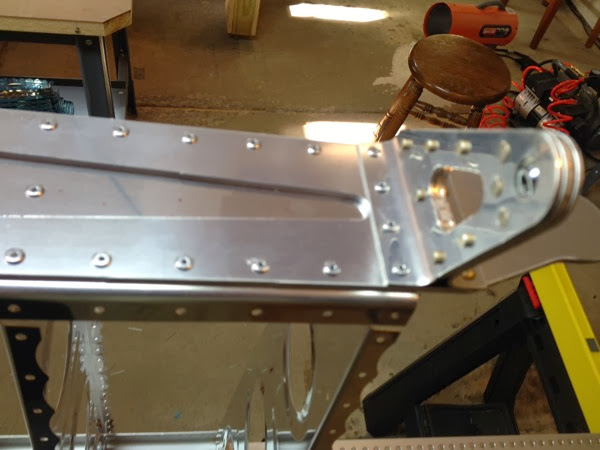
I did this page out of sequence in order to build the wing on saw horses instead of the table.
Before:

After:
The ribs are clecoed in place, prior to riveting. I try to double check everything before committing to rivets and it paid off. The inboard rib is flat out upside down (equivalently: flanges inboard instead of outboard) in this picture! Quick reversal, and all was well...

A nicer picture showing the lightening holes aligning well.

This is even cooler—the nose rib cutouts that will accept the upper skins are also as well aligned as anything I can photograph. It helps me feel more confident that I’m going in the right direction.
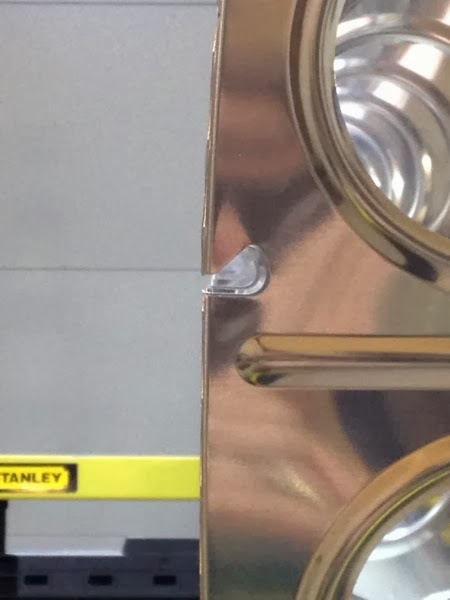
11/13/13: Here’s another deviation from the strict order of The Book. I’m building up the stall warning switch so I can install it on the appropriate rib before that rib gets riveted to the spar.
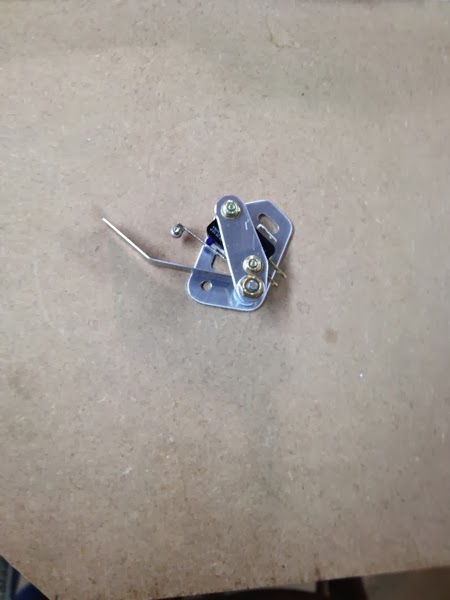
In turn, I’m not following the strict order of installing the ribs, either. I’ve clecoed the nose ribs to the L spar to make sure that I’m putting the correct “L” and “R” ribs in place before committing anything to a rivet. The stub spar has also been attached to the inboard nose ribs, although not without a comically bad attempt at installing a rib upside down (see page 15-05 for that story.)
By installing the nose ribs first, I can turn the spar over on the sawhorses and avoid putting any side loads on the ribs at all. I’m very cautious about them, as they are quite flimsy until properly skinned. While the spar is forward=up, I want to get the stall switch installed, the nose ribs attached and then do the test fit of the lower skin with respect to the stall switch. I’m hoping that keeping the wing oriented this way will relieve most of the clumsy maneuvering that I anticipate in fitting that skin over the switch. Once I verify that that the stall switch is in a good position, I’ll flip over the wing and do the main ribs, then the main (lower skins). With the lower skins in place, the wing will be mechanically much more stable. Then it goes into the cradle, and I repeat the process with the R wing.
After the main skins are on, but before the upper skins close out the wings, I’ll do the wiring kit. By that time, it should be Dec 9, at which point I will meet Bob Leffler who is an EAA Tech Counselor. He’s going to come over to my shop and check out my work. Although not really required, I want to leave the wings open for him to be able to look around.
I’m still not sure if I want to go EAB or ELSA. There’s a matter of increased pride in both directions: by going EAB I can take on the pride of “American independence” and it will be my name on the data plate. By staying ELSA, there’s the pride of “yes, I can follow directions” and have potentially easier time selling it. (Do I really care about that? Not sure....)
11/16/2013
It’s been a busy weekend, and I’m posting several pages, so feel free to get confused as you read through this. Here’s the stall warning switch installed on the rib, prior to being skinned. Note anything? Take a look at the orientation of the stall warning vane. It’s angled up, not down. Needless to say, I did note and correct that little ‘oops’. Luckily (or is it skill [no]) I did note this before attempting to put the skin on and thus damage it. While I was removing / replacing the stall switch assy, I noted that it was very rough to pivot, and would thus be difficult to adjust when the skin was on. I sanded out the inside of the race that the upper screw uses to permit pivoting and it’s better, although still not smooth.
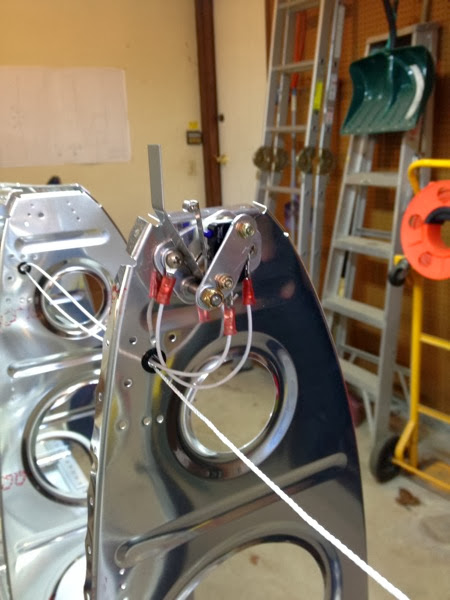
At the time of this posting, I have attached (riveted) the outer and inner lower skins, and clecloed the middle skin in place over the stall switch. It’s not yet adjusted for proper operation. I’m planning on riveting down the leading edges of the inner and outer skins so they aren’t flapping around and while the wing is right side up, adjusting the switch. With the access panel on the bottom and the open leading edge on the top, I hope to be able to do this adjustment without needing to remove the skin at all.
Side project! I’ve been putting together ideas for a few weeks and finally got around to buying the lumber and just building the wing cradle. It’s getting to be a bit tight around the garage, but I have a place to put the wings.
I started off with the “generic wing caddy” from the EAA site:
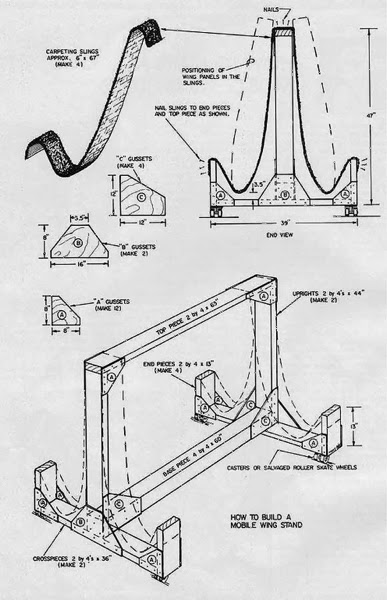
A few modifications; the outrigger uprights are 24” instead of 12”; the main piece is 8’ long, and I used a full piece of carpet instead of just two straps. I was amazed at how hard it was to cut all of that wood. I also used lots more screws than I thought I would. This thing is built like a tank, definitely overkill.
Here’s the photo with the wing spars resting down in the slings. I’m letting their weight settle the carpet before I secure the top piece with some more staples.
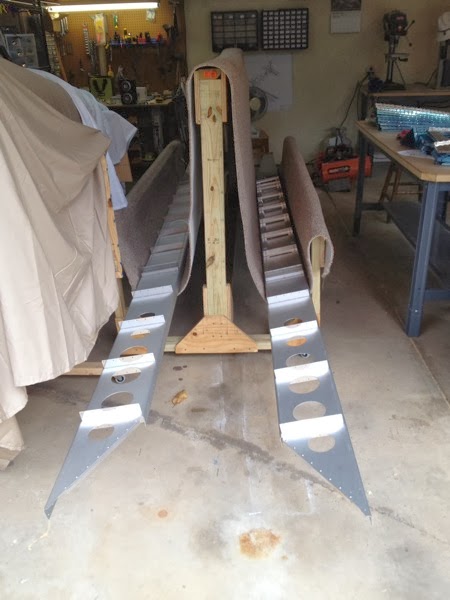
You can’t see them under the lip of carpet, but I did recycle some of the lumber from Van’s crate. The other wood is cheap stuff from Home Depot—much wetter & heavier :(
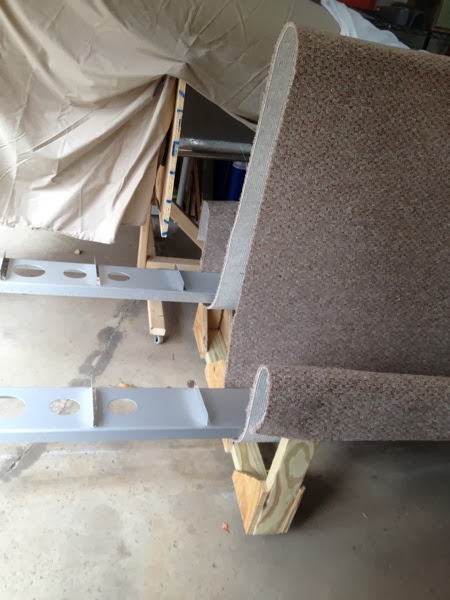
The majority of preparation for the main ribs was to flute flat and remove nearly all of the forward flanges. This picture shows all of the main ribs and the hinge assemblies after they were deburred and re-clecoed.
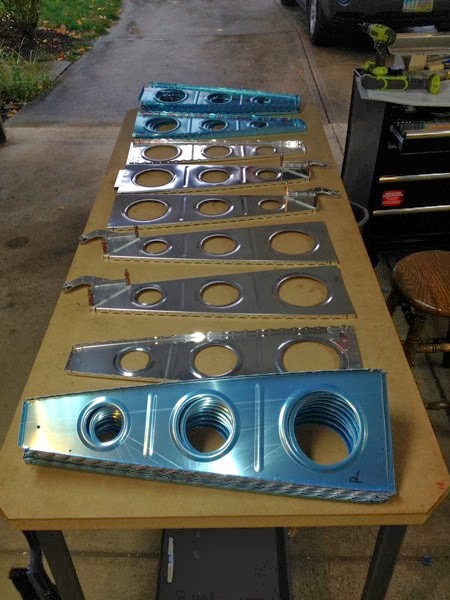
Example of a main rib clecoed to a hinge rib and flaperon hinge assembly. Note the hash marks used to allow re-assembly of all match drilled sets. The directions were very confusing here; the R and L designators of the Hinge Ribs seemed random. I played with trying to put R hinge ribs on L main ribs (and vice versa) as called out, but they just didn’t fit together. Putting R to R and L to L was much better fit and agreed with the diagram. There have been a few other places where R and L nomenclature has been wrong, so I will be searching VAF to see if I’m not alone.
[Update 11/13/13: I came back to trying to fit the hinge ribs and main ribs the way the book calls out. The advice to let things settle in your mind and try again is excellent; I had actually mated the parts as called out by the book, but didn’t realize it. My best guess is that I had the R and L hinge ribs incorrectly identified. As it stands now, the R hinge ribs are attached to the L main ribs and the L hinge ribs are on the R main ribs. Go fig! :0) ]
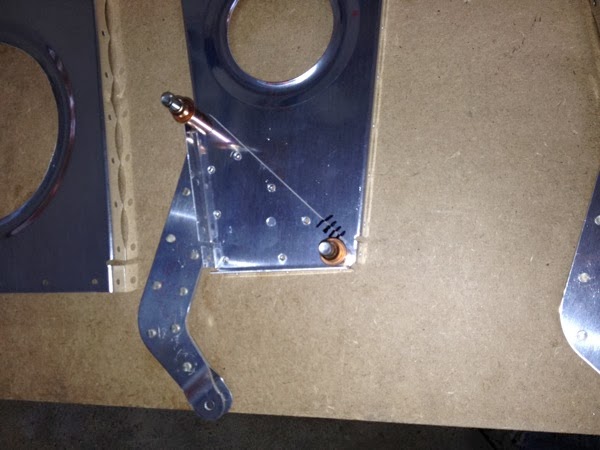
Doubler plate attached to L main rib.
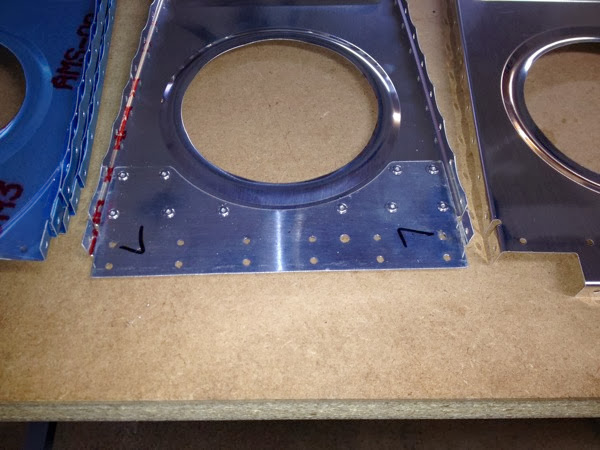
The first step in working with any ribs is to flute the flanges so that the rib lays flat. It took me a long time to do this for the tail feathers, but I was amazed at how fast the process went this time. Something ‘clicked’ in my hand/muscle/insight system and I was able to flute these ribs with just 4 - 6 gentle motions which all had a visible effect. This photo shoes a fluted rib in the foreground and an untouched one in the background. Note the background rib is visibly bowed up and you can see a sliver of light under the middle lightening hole. The foreground rib is laying flat after only a few flutes.
Here’s the entire collection; some with nose flanges removed, some with rear flanges removed, some with none removed, and others with intact nose flanges but removed rear flanges. The removed nose flanges will (probably) be where the stub spars attach. The varying lengths of the rear flanges are probably due to the stepped nature of the spars with the thickest parts of the spars being closer to midline of the aircraft.
These have doubler plates and/or K1000-8 nut plates for the electrical connections and the stall warning vane, respectively.
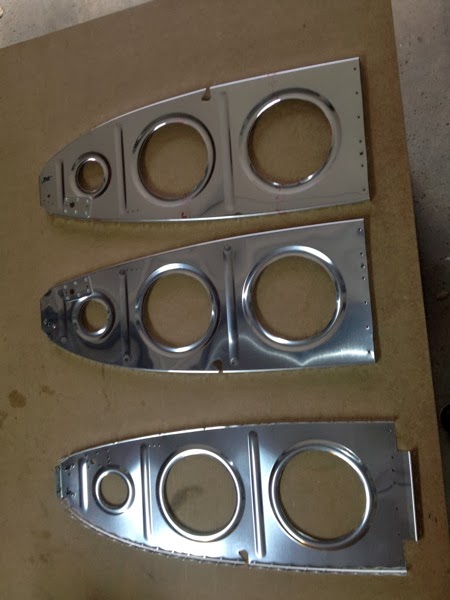
This was a pretty straight forward sheet. Rivet together the doubler plates, a curved flange and the hinge assemblies that had just been blessed as “acceptable" by tech support at Van’s.
This post is a bit different. My mentor is not able to travel to Westerville to see my project for supervision. He requested some photos of my worst work. Here they are...
Problem: Cleated rivet in rudder upper hinge assembly. See entry for 07-03 (July 2013) for a description of the creation of this problem.
Solution: Obtain expert opinion regarding the known cleated rivet. Worst case remedy is simply to purchase a new rudder. The time in de-riveting the entire structure wouldn’t be worth the cost of new material. Furthermore, I made the problem in the first place by attempting to drill out rivets.
Problem: Failed to deburr edges of factory pieces: This photo doesn’t show it, but there is a rough edge all along the upper skin. It didn’t occur to me to deburr pieces that had been cut at the factory, but now I know.
Solution: I have ordered a 2” scotchbrite wheel. I have a Dremel tool and some scrap Al. Place the scrap about 1/4” from the edge and use the wheel to deburr the edge. The scrap will prevent scratching of the adjacent skin.
Problem: On multiple occasions, the predrilled holes were too small to accept an LP4-3 rivet without either final drilling #30 or some ‘encouragement’. The photo below shows what resulted from being too firm with the rivet instead of taking the time to final drill the hole: you can see an unwanted conical dimple around the rivets.
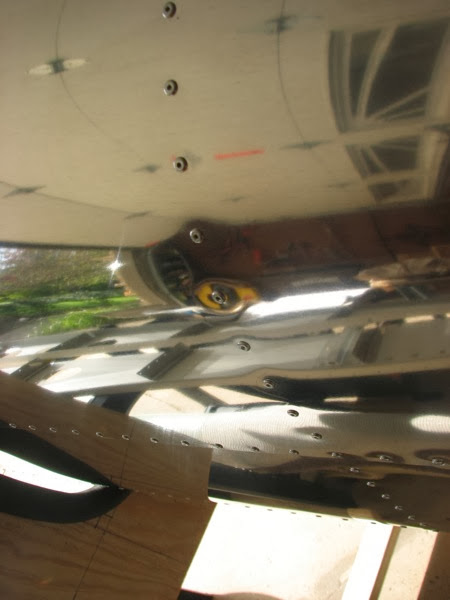
Solution: Take the time to final drill the appropriate holes. I also acquired a #30 and a #40 reamer and will see which has a better edge, since it is often impossible to deburr these holes that need finishing.
Problem: The Book called out 270AD4-4’s at 10-06 #6, which I know I placed properly, only to find that they had cleated. My analysis is that the -4 is too long, but that there aren't any 270AD4-3's. I ground down some -4's to about -3's and they installed very nicely on the other side. I drilled out one of the cleated rivets without any problem and installed a modified rivet. (These were checked with the rivet gage and met spec.) The other one (as shown on the right in the photo below) did not drill out cleanly and I was left with an ugly, out of round, nasty looking hole.
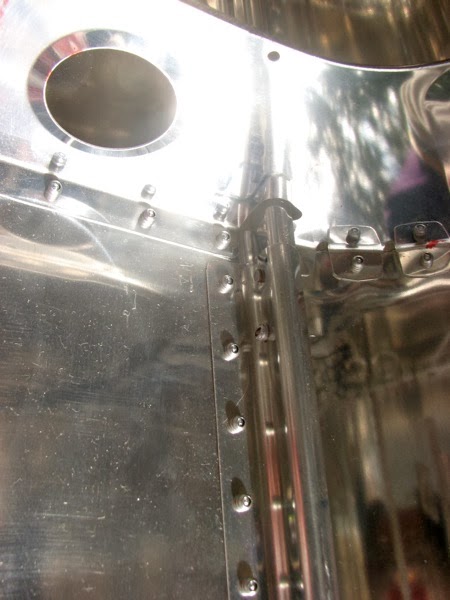
Solution: Consulting The Book, the remedy called out is to drill with the next size up and use a larger rivet. I don't have any AN270-5's, but had recently purchased a spare rivet puller with an assortment of pop rivets, including some 5/32's, for just such an occasion. One of those was installed as you see above.
Problem: The trim tabs (AST’s) are not flush with the trailing edges of the horizontal stabilizer.
Solution: Investigation to find out where the discrepancy is arising. I will remove the AST’s and see if they are actually flat along the trailing edge. I also need to verify that the HS-1217 aft skins are also flat on either side of the stabilator. While the tabs are off of the stabilator, I will also lightly file the piano hinges of the R side, as it has palpable binding and squeaks when moved.
If no solution presents itself, I will correct the mis-alignment by reinstalling the trim tabs, but not bolt them together at the control horn. The edges will be held in best possible alignment and the bolt hole in the control horns will be match drilled with a larger drill and secured with a larger bolt.
Problem: The photo shows the effect of not establishing a good bore-sight down the predrilled hole. I was actually at a 6° angle and drilled through the surface of the aluminum extrusion. Unfortunately, I was not looking at the extrusion itself, as I had turned the spar over to improve access. (I don't know if watching it would have made much difference, but I probably would have caught it earlier and been able to re-align the drill.) The tap has been re-inserted for this photo and is just barely visible at the lower end of the hole.
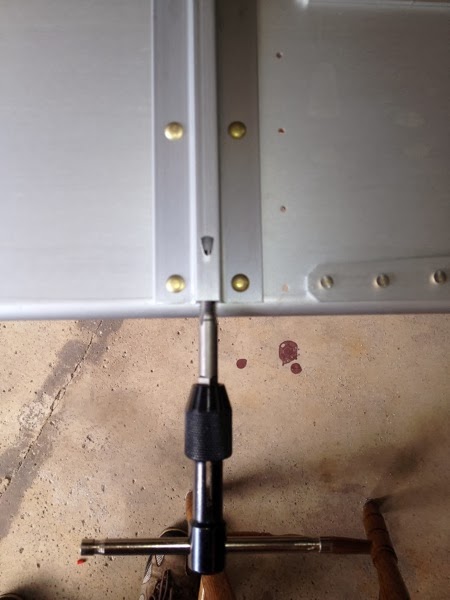
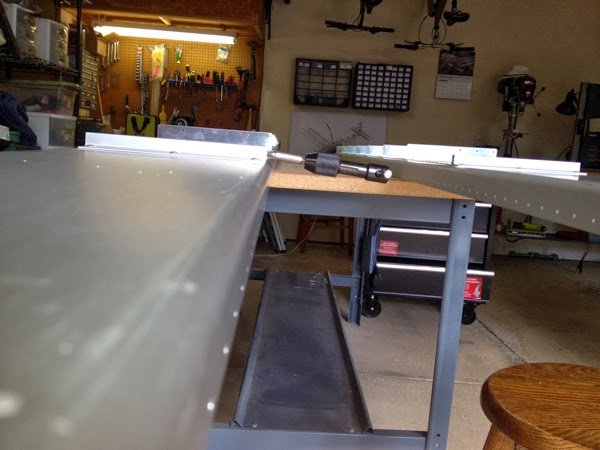
Solution:
So far, I have identified 3 paths to pursue. Easiest (and therefore of greatest suspicion) is to ignore it and use the tie down as if nothing happened. The threads are intact along the upper (as oriented in the photo) and lateral walls of the long axial hole, but probably non-existent on the lower edge of the hole directly under the unwanted opening. As a total WAG, I guess that there's a 30° arc x 1/2" where there are no threads. Is that lack of contact enough to compromise the strength of that bolt? (What is the function of that bolt, anyway? I'm further guessing that its to suspend the wing in maintenance actions.)
2nd option is to ignore it completely. That is to say mark the tie-down as InOp and never use it.
3rd option is to re-drill with a larger bit and re-tap with larger threads. To ensure good strength, I would tap 2" to obtain a full inch (original spec) of completely engaged threads. Will there be sufficient aluminum to accept the larger bolt? Hmm. Sounds like I need an engineer.
Problem: The W-1212 hinge assemblies developed a gap at the edge of the bearing.
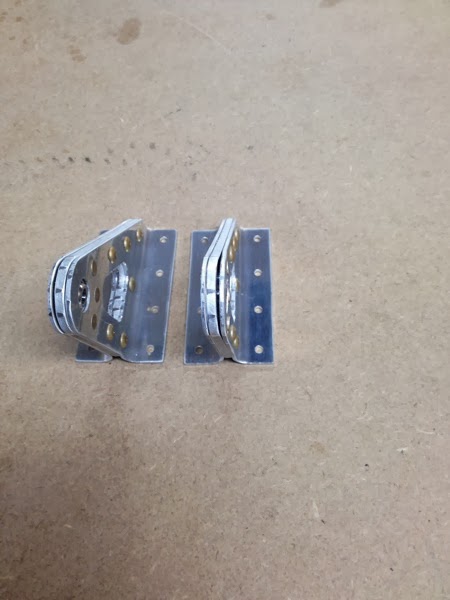
Solution: I already wrote to Van’s and submitted the above picture. I was told that they were serviceable and did not need to be remade. I also received a hint to prevent future occurrences (prestress the distal ends inward slightly prior to riveting.) No further action required.